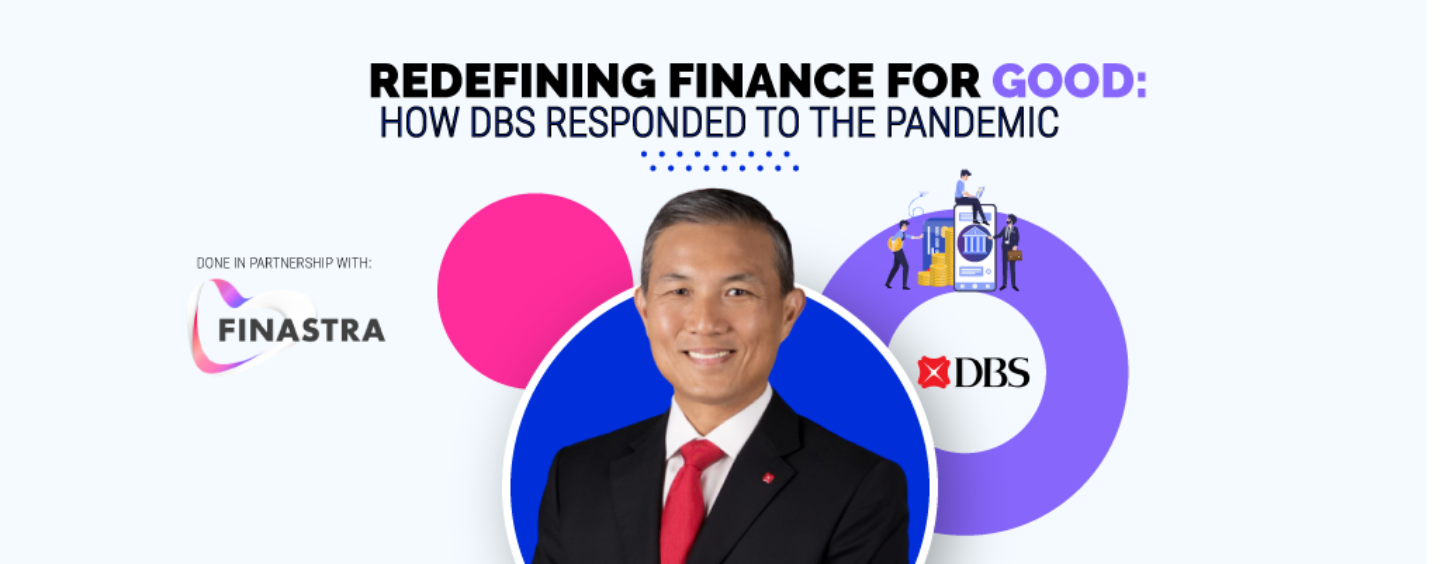
Redefining Finance for Good: How DBS Responded to the Pandemic
by Fintech News Singapore September 7, 2020The COVID-19 pandemic has no doubt shifted consumer behaviours dramatically, pushing businesses from across sectors to adapt to these new changes.
Banks are similarly impacted by these changes as well. In partnership with Finastra, we’re running a series of interviews with the industry’s top banking voices to understand how their organisations have responded to these changes.
To kick start the “Redefining Finance for Good” series we speak to Jeremy Soo, Head of Consumer Banking at DBS Bank, which often held in high regard for its digital initiatives.
New habits are here to stay
“What the pandemic has proven is that our decision to kickstart our digitalization journey in 2014 ensured that we were able to disrupt ourselves before anyone else can,” Soo, told Fintech News Singapore. “We have been building up sufficient organizational capability and muscle in our technology, our products and our people to be able to enable our customers to shift their banking habits seamlessly online.”
In the first half of 2020, Soo said the bank recorded more than 200,000 signups for its Digibank mobile banking offering. Adoption hasn’t been limited to younger, tech-savvy populations, he said, noting that in April and May 2020, the number of senior customers aged 62 and above using digital banking more than tripled compared to the same period in 2019.
While cash usage dropped to an unprecedented 29% year-on-year by the end of June 2020, online and contactless, as well as card payments have witnessed a sharp rise, Soo said. In H1 2020, DBS saw retail transaction volume on PayNow, Singapore’s interbank peer-to-peer (P2P) fund transfer service, more than doubling compared to the same period in 2019.

COVID-19 has also given e-commerce a massive push, Soo said, with more than 190,000 DBS customers activating their online spending during COVID-19, out of which, almost 30% being 51 years old and older.
Despite physical businesses progressively reopening in Singapore, usage of credit and debit cards for online purchases continues to rise, and online spending among customers above 65 years old is growing 16% month-on-month, Soo said, which showcases that these new consumer behavior habits formed during the crisis are rapidly taking roots.
“We expect this momentum to be maintained,” Soo said. “As customers shift towards consuming on digital platforms over prolonged period of time, we believe that they will recognize the conveniences and value that comes with online shopping and we would expect this to continue at a more moderate pace post COVID-19 … We also foresee that [contactless payments] may potentially displace cash transactions with consumers being more conscious about hygiene.”
In these uncertain times, DBS also observed that a lot more people are starting financial planning earlier. Since the bank launched its new digital financial planning tool, NAV Planner, in April, over one million customers have used it, Soo said.
Digital activity also picked up among DBS’s wealth clients with average logins per clients on the bank’s iWealth platform surging to 19 times within the month of March, he noted.
Fast-tracking new digital products launch
In this rapidly changing banking landscape, DBS has ramped up product development to cater to customers’ evolving needs, accelerating several rollouts which were initially scheduled for later this year.
To accommodate customers’ shift to digital banking, DBS launched in partnership with GovTech in July the SingPass Face Verification, a solution that allows users to seamlessly sign up for digital banking on their mobile phones.
In March, it introduced a new digital wealth advisory service called the TeleAdvisory, which allows clients to meet with their wealth planning manager online. So far, the service has gained notable traction and as of August 1 more than 24,000 had been scheduled through the platform, Soo said.

“COVID-19 has shortened the digital adoption timeline,” he said. “We previously expected more than 1 million additional customers to go fully digital by the end of 2021. With the number of customers going online to do their banking soaring during COVID-19, we expect to hit that target by this year.”
DBS is also involved in several philanthropic initiatives aimed at helping the hardest-hit communities. The bank launched in April the S$10.5 million DBS Stronger Together Fund which focuses on providing meals and care packs, and has partnered with organizations such as the Food Bank Singapore and ItsRainingRaincoats on similar initiatives. It also joined hands with Lions Befrienders in June to roll out Singapore’s largest-ever virtual befriending volunteer initiative to help tackle social isolation and loneliness among seniors.
One of DBS’s current focuses, Soo said, is migrant workers, a community that has historically struggled to access proper banking services.
“COVID-19 led to the realization that the lack of digital/contactless banking services for migrant workers has a real downside – from distributing salaries, and remittance services, to checking balances and transactions, and purchasing prepaid telco top-ups,” Soo said.
“Since March this year, DBS has enabled end-to-end digital opening of accounts … We saw an influx of account registrations in April from migrant worker employers … We opened some 41,000 accounts within the month.”
Interested to learn more about how we can redefine finance to build a better tomorrow? Join Finastra’s virtual summit here





